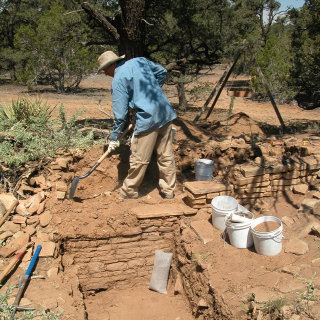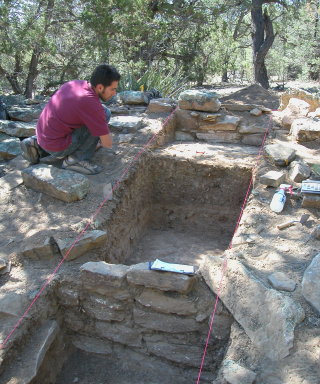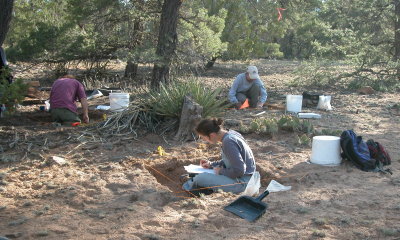Poster presented at the 69th Annual Meeting of the Society for American Archaeology, Montreal, Canada.
Abstract
The late prehistoric occupation of the El Morro Valley of west-central New Mexico provides an excellent opportunity to explore the relationship between migration and community formation in middle-range farming societies. During the AD 1200s, there was a dramatic population influx and experimentation with alternative forms of community organization in the valley. Some of these communities foreshadow the massive, nucleated pueblos of the 14th century, while others incorporate elements from earlier Chacoan villages. This poster outlines recent excavations and surveys that inform our understanding of the social organization, regional ties, and chronology of the post-migration communities of the El Morro area.
Introduction
The archaeological record of the El Morro Valley represents an excellent opportunity to examine the linked processes of migration and resettlement amongst small-scale agriculturalists (Figure 1, Cibola overview). Resettlement often draws together social groups with diverse origins and social practices to form new communities, creating situations ripe for social change (Nelson 2000; Pauketat 2003). A massive population influx in the El Morro Valley during the mid-AD 1200s coincided with the formation of new, aggregated residential communities and a number of significant shifts in social organization and public ritual, some of which foreshadowed the transformations of the early Pueblo IV period (AD 1275-1400). Our current field research is examining some of the initial aggregated communities of the El Morro Valley, with an eye toward providing insights into the relationship between movement and the onset of social change.
Prior to AD 1200, ancestral Puebloan use of the El Morro Valley was sporadic and only a few small habitation sites have been identified despite intensive, pedestrian survey of a substantial portion of the area. However, beginning in the early 13th century, hundreds of ancestral Puebloan farmers began to move into the valley, changing the area from a resource procurement zone to one of the most densely occupied parts of the Cibola region (Kintigh 1985; Watson et al. 1980). The scale and rapidity of this process suggests that immigrants were drawn from throughout the surrounding region, as many nearby areas, particularly to the north and south of the modern Zuni Indian Reservation, were depopulated during the Pueblo III period (AD 1150-1275) (Duff and Schachner 2003). Most of the early AD 1200s sites tended to be built in dense clusters along the valley margins, and exhibit variable settlement patterns, average roomblock sizes, and types of public architecture (Los Gigantes figure). At approximately AD 1280, residents of these initial aggregated settlements constructed and moved to massive, nucleated sites such as Pueblo de los Muertos and Atsinna (Picture?) (LeBlanc 2001; Kintigh 1985; Watson et al. 1980). Proposed explanations for this shift include increased conflict (LeBlanc 2001) and changes in sociopolitical organization (Kintigh 1985; Potter 1997; Stone 1992). The late, nucleated sites were also short-lived, with most remaining occupied for less than fifty years (Duff 1996; Kintigh 1985; Watson et al. 1980). The valley was finally depopulated sometime after AD 1350, when some El Morro populations left the region while others moved downstream to found the historic Zuni villages (Kintigh 1985; Watson et al. 1980).
El Morro Valley Prehistory Project
Our current research is augmenting and building upon a substantial amount of prior research in the valley. Both the Cibola Archaeological Research Project (Watson et al. 1980) and Wake Forest/University of Denver (Saitta 1994) have investigated some of the initial aggregated communities and surveyed a large portion of the valley. Excavations and surveys have also been conducted in El Morro National Monument (Bradford n.d.; Woodbury 1956). Beginning in 1998, Arizona State University archaeologists began to augment this research by surveying unrecorded areas, particularly around the Los Gigantes Community in the central portion of the valley (Huntley and Schachner 1999). More recently, as part of the ASU Summer Archaeological Field School, we have initiated test excavations at Los Gigantes as well as at roomblocks in surrounding communities. These excavations are designed to provide a more secure chronological framework for understanding the initial 13th century occupation of the valley and to generate artifact samples for investigating patterns of exchange that may provide insights into the origins and diversity of founding populations.
Los Gigantes Excavations
The Los Gigantes Community is a dense cluster of roomblocks located on top of a mesa near the center of the El Morro Valley. This site has been previously documented (LA 56109 citations), but has not been the subject of intensive examination until recently. The site includes a large, Post-Chacoan great house (LZ1200), a 31m diameter unroofed great kiva, and over a dozen nearby residential roomblocks. During the summer of 2003, field effort included test excavations at the great house and great kiva, intensive excavation of a single residential roomblock, LZ1209, and midden testing at a number of surrounding residential roomblocks.
The Los Gigantes great house is by far the largest roomblock at the site, with approximately 50 rooms laid out in a modified C-shape surrounding a probable kiva. The current rubble mound is up to 1.5m in height, and stands out quite dramatically among the rather small roomblocks in its immediate vicinity. In 2003, three rooms in two separate “wings” of the great house were tested. Although initially we thought that portions of the building were two-stories tall, these excavations indicate that only a single, tall story was originally present. However, the building includes some banded masonry and numerous internal doorways reminiscent of Chacoan great house architecture (Picture of Room 3/6). All three rooms appear to have been cleared out prior to abandonment of the building. Two of the rooms were burned, while a portion of the third may have been intentionally filled. Perhaps our most significant finding so far has been the remarkable lack of artifacts associated with this structure. Four 1m X 1m units were excavated in the adjacent midden, which ranged from 30-70cm in depth, and exhibited low to moderate artifact densities when compared to other Cibola area middens (numbers). Typological classification of ceramics suggests that the great house, as with other roomblocks in the community, was occupied in the mid-AD 1200s and was contemporary with most other sites in the valley (Table X). A number of dendrochronological samples were submitted to the Laboratory of Tree-Ring Research at the University of Arizona, which should provide a more solid footing for interpretation of chronology. We hope to add to this sample in 2004 by testing more rooms within the roomblock, excavating a few more midden units, and examining the probable enclosed kiva.

The most impressive feature of the site is a 31m, unroofed great kiva located roughly 25m to the northeast of the great house. This structure is almost identical in appearance to others excavated at the Hinkson Site (Kintigh et al. 1996) and Hubble Corner (McGimsey 1980), two other Post-Chacoan great house communities in the Cibola region. Similar structures have also been identified at potentially later, nucleated sites in the El Morro Valley, including Kluckhohn, Mirabal/Cienega, and Box S. During the 2003 season, we excavated two, roughly 1m X 3m trenches across the bench area of the great kiva, exposing the external walls, bench face, and floor. In both trenches, the bench surface was badly eroded, but appears to have been roughly 60cm above the floor and 2m wide. A knee-high wall defined the outer perimeter of the structure. Less than twenty ceramic sherds were found in the almost Xm 3 of excavated fill. All of these ceramics were consistent with the mid-1200s date assigned to surrounding roomblocks. We hope to further investigate the structure in 2004 by exposing larger portions of the interior floor.

Archaeologists have often remarked on the paucity of surface artifacts at Pueblo III period sites in the El Morro Valley. Our work at LZ 1209, a four room pueblo 100m to the northwest of the Los Gigantes Great House, was aimed at addressing site occupation length. Our research strategy at the site was modeled after the Small Site Testing Program of Crow Canyon Archaeological Center, which successfully used this strategy to monitor site occupation length at similar Pueblo III period sites in the Mesa Verde region (Varien 1999). We systematically sampled each room of the pueblo with a 1m wide trench and then used a stratified random sample to examine surrounding artifact scatters and open space. This yielded a 15% sample of the scatters and a 1% sample of open space within a 35m X 35m grid centered on the pueblo. Although final analyses have not been completed, artifact density was incredibly low in all areas. Only a handful of sherds were collected from within the roomblock, and both artifact scatters were less than 20cm in depth (Get rough #s). Of particular note was the discovery of a small, semi-subterranean pitstructure that was initially marked on the surface by a small pile of large sandstone cobbles. This roughly 2m X 2m structure was cut 50cm into underlying bedrock and included a small hearth along the southern wall, a partially slab lined floor, and rough cobble superstructure. This building is comparable to the similarly sized, but fully subterranean structures excavated near Ramah Lake for the Michaels Land Exchange (Wandsnider n.d.). Our work at LZ1209 appears to support the observation that the Los Gigantes Community was occupied for a short period of time, possibly even less than a generation, during the AD 1200s. Future research by ASU graduate student Scott Thompson should provide more secure quantitative estimates for the duration of occupation.
The 2003 field season included a testing component focused on generating artifact samples from a number of roomblocks in the Los Gigantes Community as well as in nearby areas. In most cases three 1m x 1m units were excavated in the middens of these sites. Most midden units were quite shallow, and ceramic assemblages were dominated by Tularosa Black-on-white and St. Johns Polychrome, which are indicative of 13th century occupation. Future analyses will use ceramic samples from these sites to investigate Pueblo III period exchange networks within the El Morro Valley.

Survey
Archaeological survey has been one of the most productive aspects of research in the El Morro Valley and surrounding Cibola region. Surface visibility is quite high and systematic surface collections provide reliable, high-resolution chronologies yielding excellent views of ancient settlement in the area (Kintigh et al. n.d.; LeBlanc 1978). During 2003, the ASU field school surveyed almost XXX acres, most of which were located near El Morro National Monument. This survey re-recorded a number of sites that were originally located by Charles Amsden for the National Park Service in the 1930s. The most significant site identified was a Pueblo III period community center southeast of the large pueblos in El Morro National Monument. This large complex, including LA 1581 and 1584, contains two roomblocks over 50 rooms in size and a probable great kiva. Much of the site has been impacted by an early 20th century homestead, but the size of the complex and the presence of public architecture suggest that it served as the center for a surrounding community similar to and contemporary with Los Gigantes and Scribe S. In future seasons, we hope to add to the existing survey sample for the valley, which is already yielding an exceptional view of 13th century settlement dynamics in the region.
Looking Ahead
Our research has added to the picture of El Morro Valley settlement and chronology provided by earlier projects. Currently, we see two key questions that we hope to address in future research. First, basic, chronological questions are vital to interpretation of El Morro Valley settlement and the rise of social change. The chronological assignment of some of the large, nucleated sites in the valley is currently problematic. Architecturally, sites such as Kluckhohn and Box S, are similar to well-dated Pueblo IV period sites such as Atsinna or Pueblo de los Muertos. However, the ceramic assemblages at these sites are more similar to those at earlier sites such as Scribe S or Los Gigantes, or perhaps are transitional between earlier and later sites. If these large, nucleated sites are in fact at least partly contemporary with aggregated villages, this would suggest a great deal of variability in late Pueblo III period settlement organization and that the Pueblo III-Pueblo IV settlement transition was not a synchronous event in the valley. During upcoming seasons, we hope to begin to address this problem with test excavations at some of the nucleated sites with evidence for earlier occupation. Second, data generated from this project will be utilized by the first author for a dissertation project exploring migration into the valley and its effect on community formation. This project will examine the relationship between patterns of movement and variability in Pueblo III period community organization through detailed settlement pattern studies and ceramic compositional analysis. This research should help link growing bodies of research on migration and community organization, and better define the linkages between migration and social change.
Acknowledgements
The authors would like to thank the family of Mr. Paul Davis, who have granted access to their land and generously supported us throughout our research. They are to be commended for their interest in archaeology, support of educational opportunities, and stewardship of cultural resources on their land. A number of individuals provided key support during the course of the 2003 field season. Peter McKenna graciously provided access to family property in the valley and shared his always sharp archaeological insights. Joe Nichol also allowed ASU survey teams to investigate his property. Roger Irwin of the Amaterra Foundation served as camp host, engineer, and resident philosopher. Stephanie Kulow, Josh Watts, Scott Thompson, and Sophia Kelly guided an able field crew. Suzanne Eckert provided additional opportunities for field school students and acted as an unofficial crew chief. The Department of Anthropology at ASU, Arizona State University and the Amaterra Foundation provided invaluable monetary and logistical support.
References
Bradford, James E. n.d. El Morro National Monument Survey. Manuscript and notes on file, National Park Service, Santa Fe.
Fowler, Andrew P., John R. Stein, and Roger Anyon. 1987 An Archaeological Reconnaissance of West-Central New Mexico: The Anasazi Monuments Project. Report submitted to State of New Mexico, Office of Cultural Affairs, Historic Preservation Division, Santa Fe.
Huntley, Deborah L., and Gregson Schachner. 1999 The Los Gigantes Community: Post-Chacoan Settlement in the Zuni Region of the American Southwest. Poster presented at the 64th Annual Meeting of the Society for American Archaeology. Chicago, IL.
Kintigh, Keith W. 1985 Settlement, Subsistence, and Society in Late Zuni Prehistory. Anthropological Papers no. 44. University of Arizona Press, Tucson.
Kintigh, Keith W., Todd L. Howell, and Andrew I. Duff. 1996 Post-Chacoan Social Organization at the Hinkson Site, New Mexico. Kiva 61:257-274.
LeBlanc, Steven A. 1978 Settlement Patterns in the El Morro Valley, New Mexico. In Investigations of the Southwest Archaeological Research Group: An Experiment in Archaeological Cooperation , edited by R. C. Euler and G. J. Gumerman, pp. 45-51. Museum of Northern Arizona, Flagstaff.
Marshall, Michael P., John R. Stein, Richard W. Loose, and Judith E. Novotny. 1979 Anasazi Communities in the San Juan Basin. Public Service Company of New Mexico, Albuquerque, and New Mexico State Historic Preservation Office, Santa Fe.
McGimsey, Charles R., III. 1980 Mariana Mesa: Seven Prehistoric Settlements in West-Central New Mexico. Papers of the Peabody Museum of Archaeology and Ethnology, Harvard University, Vol. 72. Cambridge.
Nelson, Margaret C. 2000 Abandonment: Conceptualization, Representation, and Social Change. In Social Theory in Archaeology, edited by M. B. Schiffer, pp. 52-62. University of Utah Press, Salt Lake City.
Pauketat, Timothy R. 2003 Resettled Farmers and the Making of a Mississippian Polity. American Antiquity 68:39-66.
Saitta, Dean J. 1994 The Political Economy and Ideology of Early Population Aggregation in Togeye Canyon, AD 1150-1250. In Exploring Social, Political, and Economic Organization in the Zuni Region, edited by T. L. Howell and T. Stone, pp. 47-60. Anthropological Research Papers No. 46. Arizona State University, Tempe.
Varien, Mark D. 1999 Sedentism and Mobility in a Social Landscape: Mesa Verde and Beyond. University of Arizona Press, Tucson.
Wandsnider, LuAnn . n.d. Michaels Land Exchange. U. S. Forest Service. Draft manuscript on file.
Watson, Patty Jo, Steven A. LeBlanc, and Charles L. Redman. 1980 Aspects of Zuni Prehistory: Preliminary Report on Excavations and Survey in the El Morro Valley of New Mexico. Journal of Field Archaeology 7:201-218.
Woodbury, Richard. 1956 The Antecedents of Zuni Culture. Transactions of the New York Academy of Sciences, series 2, 18:557-563.